


The annual reports are broken up into sections. Click on the tab heading to view the report section submited by the respective section investigation leader.

California: Mike Devencenzi, Carolyn Pickel (UC IPM), Joseph Grant (UCCE), Jed Walton, Dr. Marshall Johnson (UC Riverside, outside scientist)
Oregon: Rich Garvin, Bruce Decker, Phil Van Buskirk (OSU Extension)
Washington: Dan Flick, Nick Stephens, Karen Lewis (WSU Extension), Dr. Doug Walsh (WSU, outside scientist)
Canada: Dr. Gary Judd (Agriculture and Agri-Food Canada, outside scientist)
Although the project directors are ultimately responsible for the work
done in this project, there is also a key group of post-doctoral research scientists and
technical support personnel that have been essential to our project through their dedication and
hard work. We gratefully acknowledge their efforts to make the project a success:
Cumulative Milestones to Date:
Complete laboratory bioassays for half of the pesticides being evaluated; complete first year of
field studies.
Progress Summary:
We are meeting the goals and milestones as laid out in the grant.
This is the first year that all labs performed large plot replicated
field tests of different pesticide treatments to determine their effects on natural enemies and
pest population levels (see results below).
Plans for Next Year:
To complete the laboratory-based acute and sublethal bioassays for those natural enemy species
and pesticide combinations that remain. During the next field season we will also carry out
additional replicated field trials in each of the three states to verify the effects seen in
2010.
Implications for the Industries:
The laboratory and field assays will allow us to recommend IPM programs that enhance biological
control by minimizing disruption of the natural enemy community in orchards. The results of this
research will be added to the WSU-DAS and UC-IPM web sites this coming season. We expect these
recommendations to lead to increased biological control in our orchards, which should reduce
pesticide inputs leading to higher grower profits and lower worker safety problems and
environment issues.
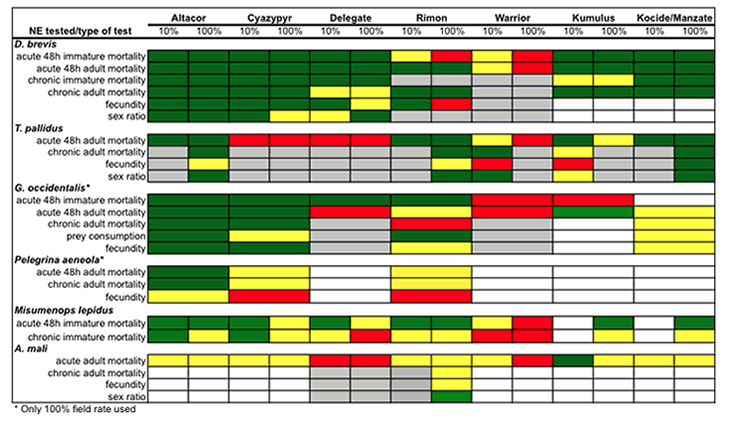
Field trials were conducted in each state. Pesticides chosen for evaluation were Delegate and Altacor with each state adding one additional treatment. The treatments were timed for codling moth management and applied either twice during the first generation (OR pears, WA apples) or once during each of the first two generations (CA walnuts). WA treatments also had a petal fall treatment of either Intrepid or Rimon applied, the other treatments were cover sprays. Treatments are summarized in the table (below). All studies were conducted in commercial orchards using plots between 0.55 - 1.5 acres in size, and with each treatment randomized in three to four replicate blocks. Aphids and spider mites (CA and WA) or pear psylla (OR) and their natural enemies were sampled at 1-2 week intervals throughout the season.

Results − Walnuts: Walnut aphid populations remained low throughout the cool summer. However, they grew to significantly higher levels in August in plots treated with Delegate in the second generation of codling moth (graph 1, arrows indicate pesticide applications). This was matched by a significant reduction in the parasitism of Trioxys pallidus during the same period for all plots treated with insecticides. This effect lasted longest in those plots treated with Delegate for the second spray (graph 2).
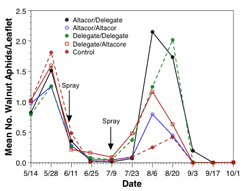
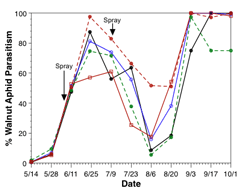
Pears: Pear psylla abundance did not differ between treatments, but the earwig data clearly showed differences between the three treatments (graph 3). The two Delegate treatments resulted in the earwig population declining and the cumulative earwig-days (a measure of the potential predation) was relatively flat after the second spray, indicating elimination of most earwigs. The earwig-days in the Altacor treatment and the Cyazypyr treatments both showed increases, but Cyazypyr had a lower impact on earwig population growth.
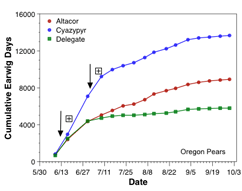
Apples: Woolly apple aphid population levels were highest in the plots treated with Rimon followed by Delegate and lowest in the Intrepid followed by Altacor treatment. These results are the same as observed in the same block in 2009. There were no significant differences in spider mite populations between treatments.
Field studies of the effect of insecticides on natural enemies focused on key groups of secondary pests and their natural enemies. The European earwig (Fig.1) can fall under both hero and villain - in some cases when prey are not available, they can cause minor damage to leaves or fruit. However, they can be key predators of aphids, pear psylla, mites, and insect eggs (including codling moth). Woolly apple aphid (Fig. 2 - the dark ones are parasitized by Aphelinus mali) can be found both above ground infesting shoots, or below ground attacking the roots.
Pear psylla (Fig. 3) is a key pest of pears and treatments for it are highly disruptive to natural enemies. Unlike apple and walnut, where codling moth drives most of the management decisions, in pears, pear psylla and codling moth each require multiple pesticide applications at different timings, which makes it difficult to tease out pesticide effects compared to the other two crops.
The walnut aphid is a key secondary pest of walnuts and is controlled by the parasitoid, Trioxys pallidus (Fig. 4). However, sprays for codling moth can disrupt T. pallidus and result in walnut aphid outbreaks. Spider mites (Fig. 5) are typically controlled by the western predatory mite, Galendromus occidentalis (Fig. 6) unless disruptive materials are applied.
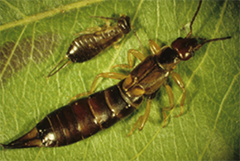
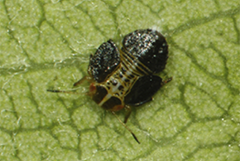
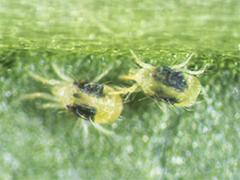
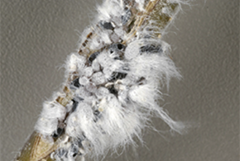

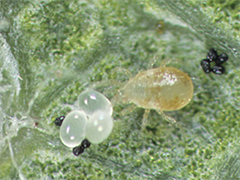
Evaluate natural enemy (NE) phenology in eight apple, five pear, and three walnut orchards.
We are exceeding the milestones as laid out in our plan of work.
Plans for Next Year: This coming year we should finish up the field studies needed for development and validation of the natural enemy models. We will also begin the preliminary analysis of phenology models for other natural enemies.
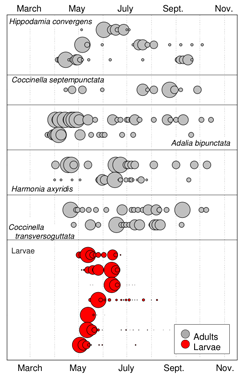
Implications for the Industries: Quantifying when, where, and how many natural enemies are present at various times of the season will allow us to design management programs to minimize their exposure to pesticides and enhance their pest suppression. The potential to use changes in phenology as a tool (as discussed below) to assess pesticide effects is a key finding.
Analysis of all the data sets shows that a common phenology model is likely to work for apple, walnut, and cherry (graph 1). We found the number of flights varies from two (WA cherries) to three and most of a fourth flight (CA walnuts).
Washington cherry orchards were missing the majority of the first flight because of spray programs during that time; after sprays stopped the second flight occurred at the normal time (graph 2 - gray box is time the first generation should occur).
C. nigicornis phenology in pear is highly distorted by the frequent pesticide applications for pear psylla. We will be obtaining the spray records, but it appears that most of the population fluctuations in pear are masked or caused by pesticide applications.
Pesticide effects are a concern in model development using data from commercial orchards, but even when phenology was distorted in a particular generation, the other generations typically occurred at the predicted times (graph 3). This distortion of phenology may be useful in assessing pesticide impacts on natural enemies and will be investigated this coming year.
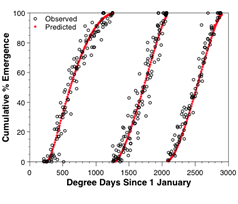
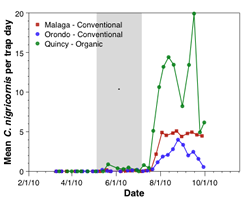
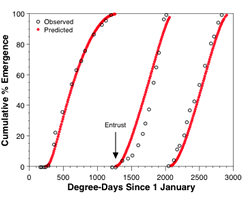
Cumulative Milestones to Date:
Complete studies on longevity and optimal release rates for eight different lures and four
different trap types to sample natural enemies (NEs) in apple, pear, and walnut orchards over
two different years.
Progress Summary:
This section is exceeding the milestones and goals of the grant.
Plans for Next Year:
Our studies on lures will be directed entirely towards optimizing lures to capture given taxa
and exclude others. We hope to be able to minimize the effort to count certain groups by
blending attractants appropriately. We will also run one more factorial experiment to evaluate
the importance of methyl salicylate and acetic acid as synergists for certain natural enemy
groups.
Implications for the
Industries:
Having new sampling tools will change pest management radically and is showing that orchards are
not the ecologically simple systems previously suspected, opening the door for broader use of
biological control tactics.
Last year we tested our HIPV traps using the white delta trap (second from right in Fig. 1). This trap is the standard trap commonly used in all three industries and it provides protection from sunlight to the lure which is placed inside the trap. However, we found this trap caught large numbers of honeybees, and appeared to be sub-optimal for some natural enemy taxa because appropriate visual stimuli were not present. To address this issue, last year we tested yellow panel traps as a replacement for the white delta traps, and found they brought in more natural enemy taxa and eliminated problem of honeybee attraction. This year we tested the yellow panels but rolled into tubes so that the lures would be protected from direct sunlight (Fig. 2). At the same time, we ran all our lure longevity studies again in mid-summer to see how the lure release rate would be affected by being placed directly in the sun. If this worked, the panels could be used as panels, rather than tubes, which is much more convenient to use in the field and to store and count in the lab.
Results: The yellow tubes were efficient at attracting syrphid flies, lacewings, and parasitic wasps in several families. Honeybee capture was minimal. Our lure longevity in the direct sunlight was very consistent, and only a few lures required modification (Fig.3 showing a subset of the data). In all cases where early depletion occurred, we were able to simply increase the amount of attractant loaded into the lure and still maintain a one-month life in the field. Next year all of our studies will use the yellow panels and lures placed directly in the sun. These will be cheaper than the delta traps, easier to handle, and easier to count because of fewer honeybees and non-target insects. In addition, our studies show that some parasitoids (e.g., Aphelinus mali, the parasitoid of woolly apple aphid) are easily monitored, even without HIPV lures.
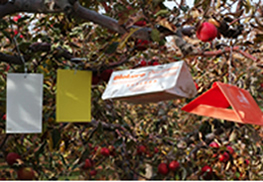
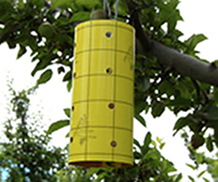
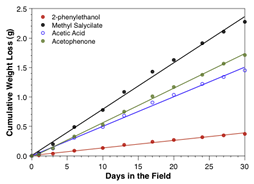
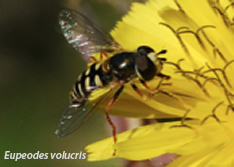
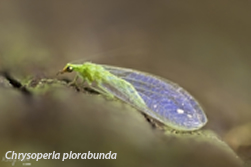
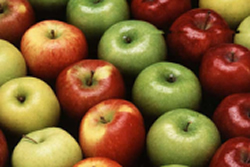
Last year, all labs evaluated a series of attractants in apple, pear, and walnut orchards. As expected, we found that there are multiple natural enemy species in common between the different systems, but the relative abundances were different between orchard types and locations. Studies in the Jones lab last year allowed us to refine a general attractant blend (geraniol + methyl salicylate + 2-phenylethanol or “GMP”) that brings in large numbers of syrphid flies (feed on aphids), lacewings (feed on aphids, spider mites, small soft-bodied insects), and specific parasitoids. That lure was particularly useful this year in our phenology studies and its use in the future should decrease the labor needed to monitor natural enemies.
The attractant studies this year in all labs concentrated on four different compounds (2-phenylethanol (PE), acetic acid (AA), phenylacetaldehyde (PAA), and acetophenone (AP)) that proved promising last year. In an attempt to evaluate the importance of these in mixtures, we ran an all possible combinations experiment (factorial) - this required us to test 16 different treatment combinations (each replicated 4 times per orchard). This trial was run three times in apple, and a single time in pear and walnut orchards. To date, only the apple data are complete enough to evaluate effects on specific natural enemies.
Results: The complete factorial design is very cumbersome and expensive to perform, but it provides a very clear picture of how the different attractant combinations work in the field. For the syrphid fly, Eupeodes volucris, it is clear that its response is similar in all three apple orchards, with the best attractant being PE by itself (right tan bars on graph below). Addition of any of the other compounds did not improve capture, and many combinations actually decreased the capture over PE alone. This is in contrast to the lacewing Chrysoperla plorabunda, which responds to a wide range of blends and nearly always responds better with two or more of the attractants (gray bars on graph below). For C. plorabunda, the top binary blends were not significantly different from either the three or four component blends.
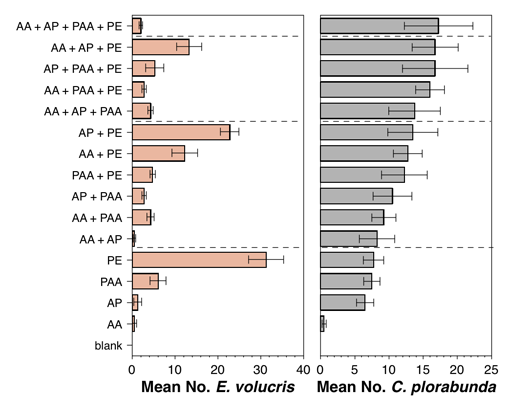
Other Experiments: Over multiple experiments, it appears that both acetic acid (AA) and methyl salicylate (MS) are relatively inactive on their own, but act to synergize the activity of other attractants, at least for C. plorabunda. In contrast, E. volucris attraction in four different experiments was always best with single attractants, and multiple attractants either made no improvement or significantly reduced trap catch.
In another factorial experiment, attraction of C. plorabunda was tested where both MS and AA were run in combination with PAA. We found the three way combination was highly synergized by the combination of both MS and AA with PAA, compared to the single blends or the different two way combinations. This effect of AA and MS is one that will be tested this coming year in combination with other attractants.
Next Year: Running the full factorial experiment allows us to custom tune a blend to attract a range of natural enemies and reduce capture of those of less interest. Once the full data set from all labs is available, we will design some blends that attract the desired range of natural enemies and test them in the field next year. For example, our apple data suggest that we could use several of the three component blends (e.g., AA + PAA + PE) to limit catch of E. volucris, while still capturing C. plorabunda. We will also run one more factorial experiment this coming year, combining the best attractants of 2009 and 2010 to finalize our blends down to 3-4 lures targeting key natural enemy taxa.
Cumulative Milestones to Date:
Field video monitoring of and complementary laboratory feeding trials with potential codling
moth (CM) predators. Development of a robust and reliable method for molecular gut contest
analysis of arthropod CM predators.
Progress Summary:
This section fell slightly behind the milestones and goals of the grant due to unanticipated
difficulties. We expect to meet the milestones and goals again after year 3.
Implications for the Industries:
The gut content analysis weighted by predator abundance will help clarify which natural enemies
are important for our conservation efforts as well as providing targets for our monitoring
efforts.
Plans for Next Year:
Lab studies to test an improved DNA preservation fluid for pitfall trapping will be performed
this winter. We will repeat season-long trapping of ground-dwelling predators employing the
improved storage medium and new PCR protocols throughout the season. In addition, >2,000
existing frozen dry-trapped predator samples will be processed.
We will also complete lab studies on the digestion rates of P. melanaria, earwigs, and Opiliones to clarify interpretation of positive gut content assays (i.e., if digestion is complete by 24 hrs then a positive result would suggest at least one feeding event in the past 24 hrs).
Additional field studies will provide new estimates of predation rates by ground dwelling arthropods using two methods:
Four arthropod groups that were large enough to be potential predators of free living or cocooned codling moth (CM) larvae were collected by pitfall trapping and tested in the lab. Pictured below (from left to right), these arthropod predators were harvestmen (Opiliones), several species of large wolf spiders, the predatory ground beetle Pterostichus melanaria, and the European earwig (Forficula auricularia). Each predatory species was offered either late instar CM larvae or cocooned CM larvae and their behavior and prey consumption were monitored in 70-100 replicates/species/host type.
The studies showed that earwigs (93%) and daddy long legs (95%) ate free-living CM larvae but not cocooned larvae (0% for both species). In contrast, the carabid beetle, P. melanaria and wolf spiders ate both free-living 5th instar larvae and cocooned larvae equally (>95% for both host types for both species). The carabid and the wolf spiders were voracious predators; they attacked and consumed the CM larvae within one hour of presentation; cocooned CM consumption took several hours. The daddy long legs and earwigs were slower at prey consumption and took many hours (4–24) to attack and consume the free-living larvae.
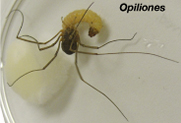
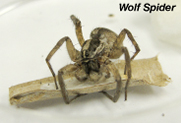
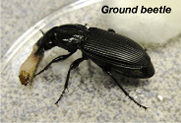
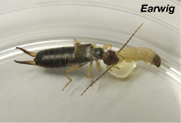
Cumulative Milestones to Date:
Gather data from objective 1 to evaluate estimates of IPM cost structures. Develop an expected
profit model with data on indirect IPM benefits obtained from survey.
Progress Summary:
This section is meeting the milestones and goals of the grant.
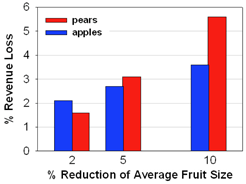
Plans for Next Year:
The next step in applying our economic model to pest control scenarios will be to incorporate
synthesized information from Objectives 1 and 2 into a more realistic representation of the
impact of OP alternatives on BC. Input from pear and walnut growers is being collected in order
to develop an economic model similar to apple. The survey interviews to evaluate the growers’
willingness to pay for BC will continue for apple and will be conducted for pear and walnut.
Implications for the Industries:
Information generated by economic models and surveys will help to inform growers and consultants
of the value of conserving BC agents in orchards. The outcomes will be used in designing
education programs that link the relative impacts of new insecticides on natural enemies based
on results from objectives 1-2.
The budget developed for nine IPM scenarios assumed different densities (pressure) of the key pest, codling moth (CM) and typical pesticide programs. The value of biological control (BC) is built into the assumed negative impacts of certain pesticides on BC agents resulting in additional pesticide inputs (increased costs). Program costs per acre include the costs of the active ingredient plus application.
In general, results show that lower initial pest pressures lead to lower total pesticide costs. Traditionally, pesticide programs based on organophosphate (OP) alternatives + mating disruption (MD) are thought to be more costly than programs based on OPs only. However, we found that OP-alternative programs are not always more costly (table below).
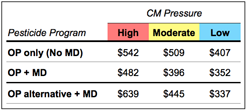
The budget was applied to our economic model, which used six likely scenarios that reflect expected change in practices over a five year period. These scenarios assumed different CM pressures (risk of crop injury) and grower pesticide use that would provide acceptable control of all pests.
Results Scenario 1 is an OP-based program, initially without MD, starting with high pest pressure that transitioned to a low pest pressure OP + MD program. This sequence would not represent current practice but might have occurred historically. Due to the initially high CM pressure, it is not the cheapest scenario even though OP costs are lower than OP-alternative costs.
Pesticide programs in scenarios 2 and 3 are OP-based transitioning to OP alternative + MD programs. The cost of scenario 2 is the highest of all scenarios because of the switch from OPs to OP alternatives with high CM pressure. In contrast, scenario 3 with an initial moderate CM pressure resulted in lower total program costs.
Scenarios 4-6 represent OP alternative + MD programs that start with different pest pressures. These scenarios represent likely patterns that might be encountered as OP insecticides are phased out. All these scenarios have a lower five-year cost than the OP based programs in scenarios 1 and 2.
Scenario 6 represents a desired stable and sustainable IPM program using enhanced BC. It is the least expensive of all the scenarios over five years and points out the potential value of BC through conserving natural enemies in apple orchards.
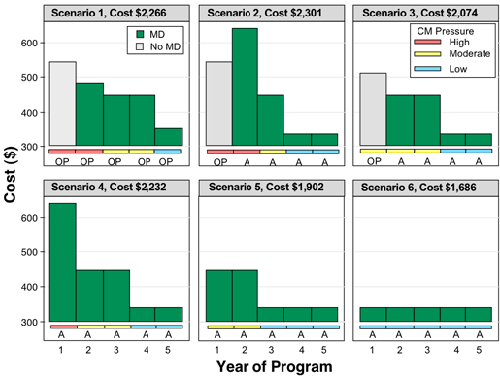

Cummulative Milestones to Date:
Survey of walnut growers is completed and analysis has begun; the project website is set up
providing details on progress and general information to stakeholders.
Progress Summary:
This objective is ahead of the goals and milestones assigned by the grant.
Plans for Next Year:
We will send out our survey to Oregon pear growers. The apple survey will be prepared next year
and sent out in 2011. We will develop new IPM programs by integrating data from objectives 1 and
5. In addition, we will usher in the implementation of the project’s educational program. The
goal is to deliver a synthesis and transfer new knowledge and technology to stakeholders in a
manner that will provide a lasting impact.
Implications for the
Industries:
Our surveys of growers and consultants are providing the information needed to improve outreach
and leave a legacy of information once the project is completed.
Survey Methods
A survey of California walnut growers (N=2,688) in the top-ten walnut-producing counties was
conducted from March through June 2010. Half of growers received a paper questionnaire, the
other half was asked to participate in the survey online. The response rates for the two groups
were 31% and 11%, respectively (21% combined).
Orchard
Characteristics
The majority of survey respondents (87%) were orchard owners, partners, or lessees, while 9%
were hired managers. Approximately 70% of respondents described their farm operations as family
or individual operations. Respondents operated, on average, 385 acres of farm/ranch land in
2009. Over one half (54%) of respondents produced walnuts in addition to other agricultural
products (e.g., almonds, cherries, grapes, peaches, prunes).
Pest Management
Decision-Making
When making pest management decisions, 75% of respondents rated economic cost and health impacts
as “very important”, while 60% believed environmental impacts are “very important.”
The most important sources of information for making pest management decisions were Pest Control Advisors (PCAs) affiliated with chemical companies, followed by insecticide label information, formal education and continuing education classes, University of California Cooperative Extension (UCCE) publications, and UCCE advisors.
Most survey respondents (90%) used the services of a PCA. Of those respondents, 17% consulted with their PCA more than once a week, 33% once a week, 25% every 2-3 weeks, and 26% once a month or less. Most respondents (90%) followed either most or all of their PCA’s advice.
Survey respondents reported varying levels of contact with UCCE with regard to their walnut orchards. The most frequent forms of contact were reading UCCE bulletins (76%), attending meetings, workshops or field days (63%), and visiting UCCE websites (45%). Office visits, on-farm visits, and research collaborations with UCCE advisors were less common (39%, 25%, and 18%, respectively).
General Pest
Management
Respondents were asked about changes in their use of selected pest management practices during
2007–2009. Nearly 30% of respondents decreased their use of insecticides more harmful to
non-target species. Over 25% of respondents increased their use of insecticides less harmful to
non-target species; 20% increased their use of monitoring for insect pests; 14% increased their
use of pheromone or sticky trips; 11% increased their use of monitoring for natural enemies; and
8% increased their use of biological control practices.
Biological Control
Practices
Over half (54%) of the survey respondents relied on one or more biological control practices to
control for insect pests in their walnut orchards in 2009. Of those respondents, 87% minimized
factors that harm natural enemies, 39% enhanced natural enemy habitats, and 6% released
commercially produced natural enemies. Respondents, on average, had been using “conservation
biological control” (i.e., minimizing factors that harm natural enemies and enhancing natural
enemy habitats) for 10 years and “augmentative biological control” (i.e., releasing commercially
produced natural enemies) for 7 years.
Primary Walnut Pests
Respondents were asked if they select insecticides and time insecticide applications (for
control of primary walnut pests) so they are least disruptive to the natural enemies of
secondary pests. They were also asked if they use spot sprays to minimize harm to the natural
enemies. Responses indicate that selective insecticide choice and application timing are more
common than spot sprays (see table).
Secondary Walnut Pests
Survey respondents were asked if certain secondary walnut pests required treatment in their
walnut orchards in 2009. The following pests required treatment by the reported percentages of
respondents: twospotted or Pacific mite (43%), European red mite (16%), walnut aphid (9%),
scales (7%), redhumped caterpillar (4%), leafroller (3%), green fruitworm (1%), and dusky-veined
aphid (1%). Forty-four percent of respondents reported that no secondary pests required
treatment; 11% did not know if secondary pests required treatment. Most respondents report that
they did not face increased secondary pest problems during 2007-2009.
First Conclusions
The survey responses demonstrate that the educational process needs to be strengthened,
including IPM critical content and ways to improve information transfer.
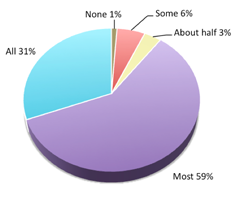
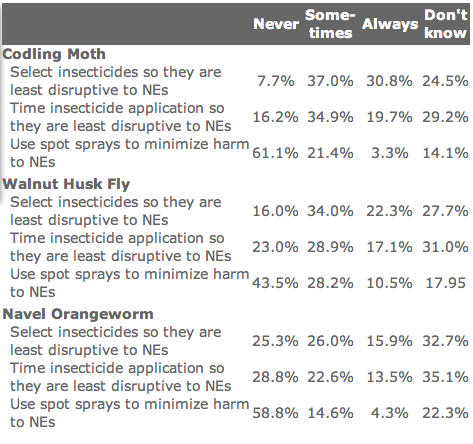

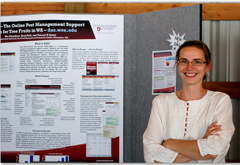
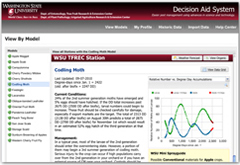
We will have a 3 hour symposium on our project at the Entomological Society of America Annual Meeting in San Diego, CA (15 Dec. 2010) entitled “Building the Framework to Enhance Biological Control in Orchard System: Progress and Problems in the Western U.S.” - 10 presentations: